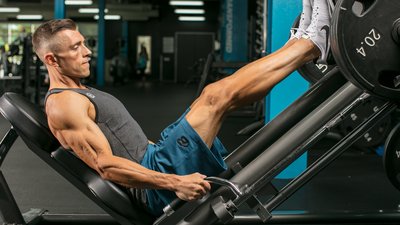You'd think the leg press would be idiot-proof. But nope! Like anything else in the weight room, there are any number of ways you can mess it up.
Because you don't have to balance the load as you do with squats, the leg press allows you to focus on simply moving the weight from point A to point B. That enables you to go somewhat heavier than you'd normally be able to do with a free-weight move. Heavy weights combined with bad form can be a recipe for injury.
What can go wrong? Let's take a look at six common mistakes you can make on this solid leg movement.
1. Lowering the Sled Too Far
One of the advantages of leg presses over squats is that the machine supports your back. But while it's next to impossible to get the thoracic spine off the pad, your lumbar is still vulnerable. When you allow the sled to come down too far, it lifts your butt and even the lower region of your back off the pad. That's when your lumbar disks are most at risk, especially if you aren't in total control of the sled.
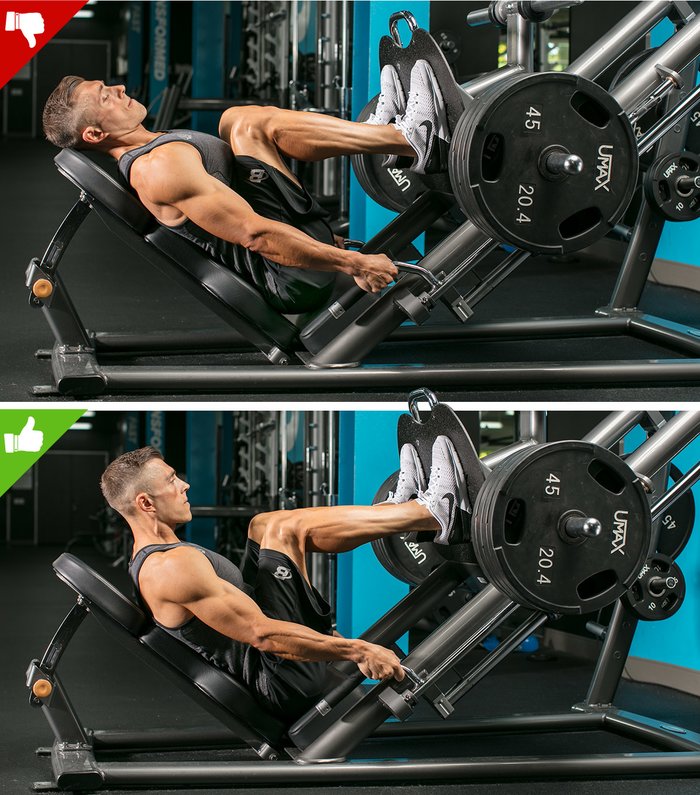
Control the negative at all times, lowering the sled to a point just before your glutes lift off the seat. You may need a spotter's trained eye viewing from the side; then establish—and practice— this as the end of your range of motion.
Remember, just because you can take the movement even lower doesn't mean you should.
2. Doing Only Shallow Reps
Yes, the depth critique goes both ways! If you haven't heard the refrain "partial reps equal partial results," you'd best memorize it. Anyone can load an impossible amount of weight on a bar or machine, but if you move it only an inch or so—like I've see all too many people do—you're getting next to zero benefit.
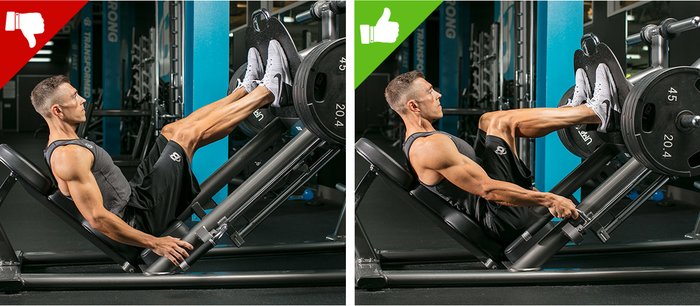
So-called partial reps don't target all the muscle fibers of the legs by a long shot. You're simply not working the muscle adequately if you're doing only quarter-reps or even half-reps.
Going a little deeper engages the glutes and hams to a greater degree than staying shallow, especially on the negative. Try to lower the weight to a point at which your thighs are about parallel with the foot sled; your knees should be bent about 90 degrees.
3. Not Having Your Heels on the Sled
Not every foot plate has a large surface area; when you're stuck using a unit with a small one, you may be tempted when trying to emphasize the quads to push your heels off the lower edge of the platform. You definitely shouldn't.
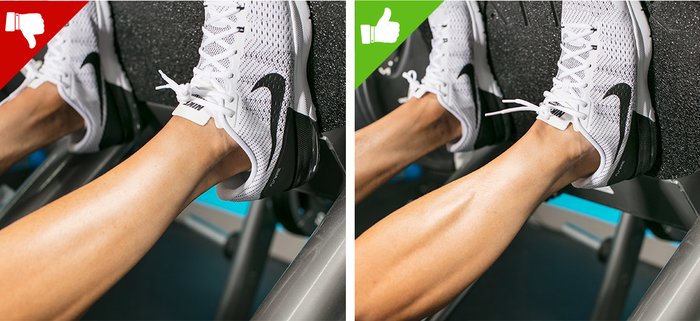
"Your base of support becomes much smaller when your heels lift off, leaving you unbalanced and reducing your ability to perform a controlled rep," says Ciaran Fairman, MS, CISSN, a doctorate student in kinesiology at The Ohio State University. "Second, you have much less force production than if you were to have your full foot in contact, which also allows you to drive through your heels. Finally, lifting the heels will increase shear forces on the knee. Essentially, you won't be able to lift as much, you won't have as much control over the weight, and you'll be putting more pressure on your knees than necessary." [1]
The problem is similar for individuals whose heels come up off the footplate at the bottom of the negative rep. Those folks should address ankle mobility and reposition their feet so that they have the entire foot in contact with the sled at all points of the range of motion.
4. Allowing Your Knees to Collapse Inward
This is typically more common in women, says Fairman.[2,3] "It increases your risk of injury, most often via anterior cruciate ligament (ACL) tears. This often arises because of weak hip abductors, and the gluteus medius in particular. Knee valgus should be taken seriously and addressed immediately."
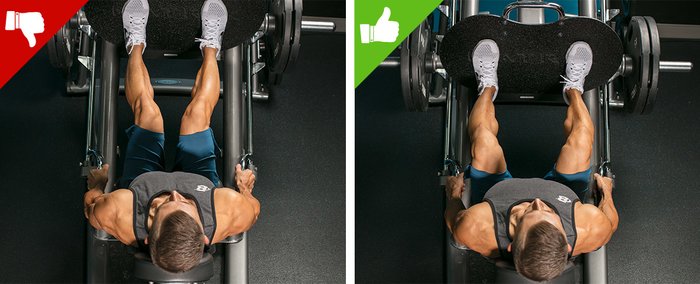
Here are some tips from Fairman to avoid valgus during leg presses (or squats):
- Do banded movements often, or even wear one on the press. Placing a band around the top of the knee creates tension, which helps people be cued to drive their knees outward during the movement.
- Work on strengthening the posterior chain, paying particular attention to the gluteus medius. Good exercises include deadlifts, Romanian deadlifts, single-leg Romanians, and lunges.
- Jump on the hip-abductor machine (the one in which you push your legs outward) to activate and strengthen the gluteus medius.
5. Turning Your Feet Excessively Inward or Outward
You've probably heard that turning your feet inward or outward on leg extensions and leg curls can help you direct the stimulus to emphasize the quads or hamstrings, respectively. That's true, but what's good on one machine isn't always good on another.
The leg extension and curl are open-chain exercises, meaning your feet aren't planted against a solid surface. But when you're doing the leg press, which is a closed-chain movement where your feet are planted, turning your feet excessively can create pressure that will be absorbed by the knees. For most people, the best position to start with is going to be feet shoulder-width apart and turned slightly outward, making only minor adjustments in foot position.
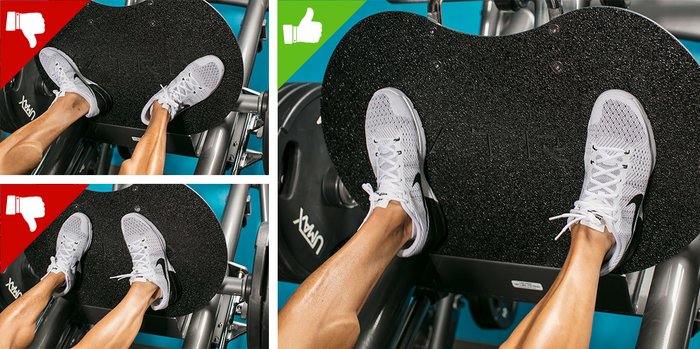
Of course, there are ways you can still use foot position to shift the focus from one area of the thighs to another. A low foot position more effectively focuses on the quads, because there's less hip extension and greater knee flexion, while a high foot position better hits the glutes and hamstrings with more hip extension and less knee flexion.
Wider stances, which are a favorite of long-limbed lifters, work the inner thighs and glutes more strongly; conversely, a closer stance better targets the outer thighs.
6. Locking Out Your Knees
While you're always encouraged to take each rep close to full extension, there's a fine line between extension and lockout. That's an important point, because it's where the stress heavily shifts from the muscle and onto the joint, and that pressure can be enormous when you're using heavy weights.
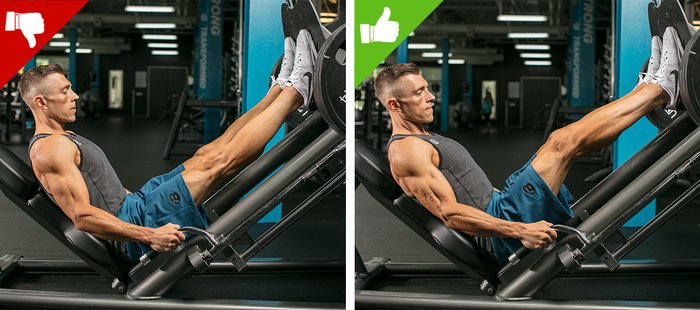
When you're locked out, you're most likely catching your breath between reps or resetting your focus. But it's also giving your muscles a break from the tension. So it's both bad for knees and counterproductive to your muscle-building goals.
Try to go to a point just shy of full extension; if you're got pre-existing knee issues, stop about 10 degrees short of lockout, so the bones don't have maximum surface contact.
References
- Lewis, C. L., & Sahrmann, S. A. (2006). Acetabular labral tears. Physical Therapy, 86(1), 110-121.
- Quatman, C. E., & Hewett, T. E. (2009). The anterior cruciate ligament injury controversy: is "valgus collapse" a sex-specific mechanism? British Journal of Sports Medicine, 43(5), 328-335.
- Ford, K. R., Myer, G. D., & Hewett, T. E. (2003). Valgus knee motion during landing in high school female and male basketball players. Medicine and Science in Sports and Exercise, 35(10), 1745-1750.

